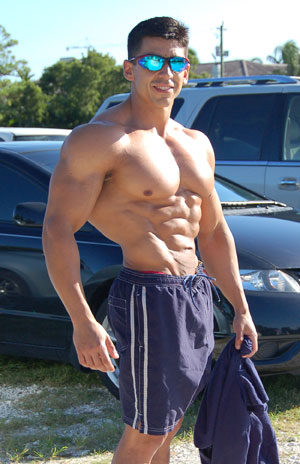The more I frequent several gyms across the nation, the more I see a trend of people emphasizing machine work over free weights. While I think machines are great for beginners, for those who are nursing an injury, or for finishing work designed to target specific muscles, the majority of your bodybuilding routines should be composed of free weight exercises in order to achieve the fastest bodybuilding gains. In this article, I will explain why that is the case and I will also give you a method for rating the effectiveness of each exercise.
The Best Bodybuilding Exercises for Lean Muscle Mass Gains
Which bodybuilding exercises are the best ones for lean muscle mass gains? This is one of the most common questions that I get asked on almost a daily basis. In weight training, there is a variety of exercises that one can choose from to sculpt the body of your dreams. Results in bodybuilding are generally measured in body composition changes; increased muscle mass or tone, depending on the goal, along with decreases in body fat. The speed at which such changes are acquired depends on the training protocol used, the nutrition plan followed and the amount of rest (good night sleep) that the trainee gets.
In order for a training protocol to work at peak efficiency, not only must it be periodized or cycled but it also must include exercises that give you the most stimulation in the minimum amount of time.
Different exercises provide different levels of stimulation. Exercises like the leg extensions, while excellent for sculpting the lower part of the quadriceps, produce less of a stimulating effect than an exercise like the squat. The efficacy of an exercise really depends on the exercise’s ability to involve the maximum amount of muscle fibers and also on its ability to provide a neuromuscular stimulation (NMS).
Neuromuscular stimulation is of crucial importance as it is the nervous system that ultimately sends a signal to the brain requesting to start the muscle growth process. Having said that, how do we determine what the stimulation factor of each exercise is? Such will be the topic of the next section.
NMS Classes
In order to rate what the NMS of each exercise is, I borrowed the Class rating system that was used for classifying the speed of DSL systems (an older technology that was used to achieve high-speed connections to the Internet through a copper phone line) and tailored it to fit my purpose. In this system, a Class 1 technology has lower speeds than a Class 2 technology.

Therefore, in our exercise rating system composed of four classes, a Class 1 exercise yields the lowest NMS (this class is composed of variable resistance machine type of exercises) while a Class 4 exercise yields the highest NMS and is, therefore, the hardest but most stimulating one. In each class we may also have subclasses such as Class 1a and Class 1b. A Class 1a exercise will yield less NMS than a Class 1b.
Class 1a
Class 1a exercises are composed of isolation (one joint) exercises performed in variable resistance machines (such as Nautilus) where the whole movement of the exercise is controlled. These type of exercises provide the least amount of stimulation as stabilizer muscles do not need to get involved since the machine takes care of the stabilization process. An example of such an exercise would be the machine curl.
Class 1b
Class 1b exercises are compound (multi-joint) movements performed in a variable resistance machine. An example of such movement would be the incline bench press performed in a Hammer Strength machine. Since the movement is a compound one, more muscles get involved and therefore the neuromuscular stimulation is higher than that offered by a machine curl for instance. However, the fact that the machine takes care of the stabilization issues limits the growth offered by the exercise.

Class 2a
Class 2a exercises are composed of isolation (one joint) exercises performed with non-variable resistance machines. An example of such exercise would be the leg extension exercise performed in one of those leg extensions attachments that come with the benches that are sold for home gyms. These attachments lack the pulleys and the cams that would make the exercise a variable resistance exercise. Therefore, the muscles need to get more involved in the movement, something that as a result provides better stimulation.
Class 2b
Class 2b exercises are composed of basic (multi-joint) exercises performed with non-variable resistance machines. An example of such would be the bench press unit that is attached to the Universal type of machines or a leg press machine that contains no pulleys or cams that would make the exercise easier. Since there are no pulleys or cams to make the exercise easier as you lift the weight, the NMS is higher.

Class 3a
Class 3a exercises are isolation (one joint) exercises performed with free weights. An example of such exercise would be a concentration curl performed with a dumbbell. It is still not very clear whether a multi-joint exercise performed on a machine offers the same amount or better NMS than the one offered by a free weight isolation exercise. However, for the purposes of this discussion, we will assume that the free weight isolation exercise provides more stimulation as stabilizer muscles come into play (especially if you do the exercise standing up).
Class 3b
Class 3b exercises, as you probably guessed by now, are multi-jointed basic exercises performed with barbell free weights.

Class 3c
Class 3c exercises are multi-jointed basic exercises performed with dumbbell free weights.
The barbell exercises provide less NMS as the movement is more restrained as opposed to dumbbells where the weights can go in all types of directions unless all of your stabilizer muscles jump in and constrain the movement. Because of this, dumbbells provide the highest NMS in this category.
Class 4
Finally, Class 4 exercises, the king of exercises, are free weight exercises where your body moves through space. In other words, any exercise where your torso is the one moving, such as squats, deadlifts, pull-ups, close grip chins, pushups, lunges, and dips, will provide the most stimulation possible and therefore, the fastest results. Haven’t you seen at the gym how many people do great amounts of weights in a pulldown machine but have trouble doing pull-ups?

The reason for this is that in order for you to perform these type of exercises you need to be capable of not only carrying the added resistance but also involving your bodyweight as well. Therefore, many muscles are called into play in order to perform this feat. If you look at it, by performing dips, chin ups, squats, and deadlifts you are really hitting every single muscle in your body! These exercises not only give you fast results, but they also create functional strength; in other words, strength that can be used for your daily activities.

If you are great at performing pull-ups and you go to perform a pulldown you’ll see how easy the task of performing a pulldown is. As a matter of fact, depending on your pull-up strength, you might be able to lift the whole stack in most pulldown machines. However, the reverse is not true. While you may be very good at performing pulldowns you may not be able to perform many pull-ups as the strength gained in the pulldown exercise is not as transferable as the one gained in a pull-up. Again, the reason for this phenomenon is NMS.
Conclusion
Now that you know what exercises are the ones that give you the most bang for your buck, then my recommendations are the following:
If you follow very low volume routines (3-7 sets per bodyparts), please choose only exercises in the Class 3b, 3c and 4 region.
If you follow a medium volume type of routine (8-13 sets per body part), stick mostly to Class 3b, 3c and 4 type of exercises but for those bodyparts where you perform 12 or 13 sets, you may want to incorporate 2 or 3 sets at either the beginning or at the end of the workout from one of the lower classes. This is especially true for legs in which a leg extension movement at the beginning of the workout is a great tool for pre-exhausting the quads or at the end of the workout serves as a great finishing movement.
For high volume routines (14-20 sets per body part) you can get away with having 1/3 of your routine composed of lower class (Classes 3a and below) exercises.
Remember, convincing your body to grow and develop muscle is not an easy task. However, it becomes an impossible one if you choose exercises that do not provide a significant NMS effect. Therefore, always choose exercises from the higher classes in order to show your body that you mean business.
Please Let Us Know If You Enjoyed This Article.
Your Feedback Is Important To Us
Disclaimer: This content is for informational purposes only and is not meant as medical advice, nor is it to diagnose or treat any medical condition. Please consult your physician before starting or changing your diet or exercise program. Any use of this information is at the sole discretion and responsibility of the user.













